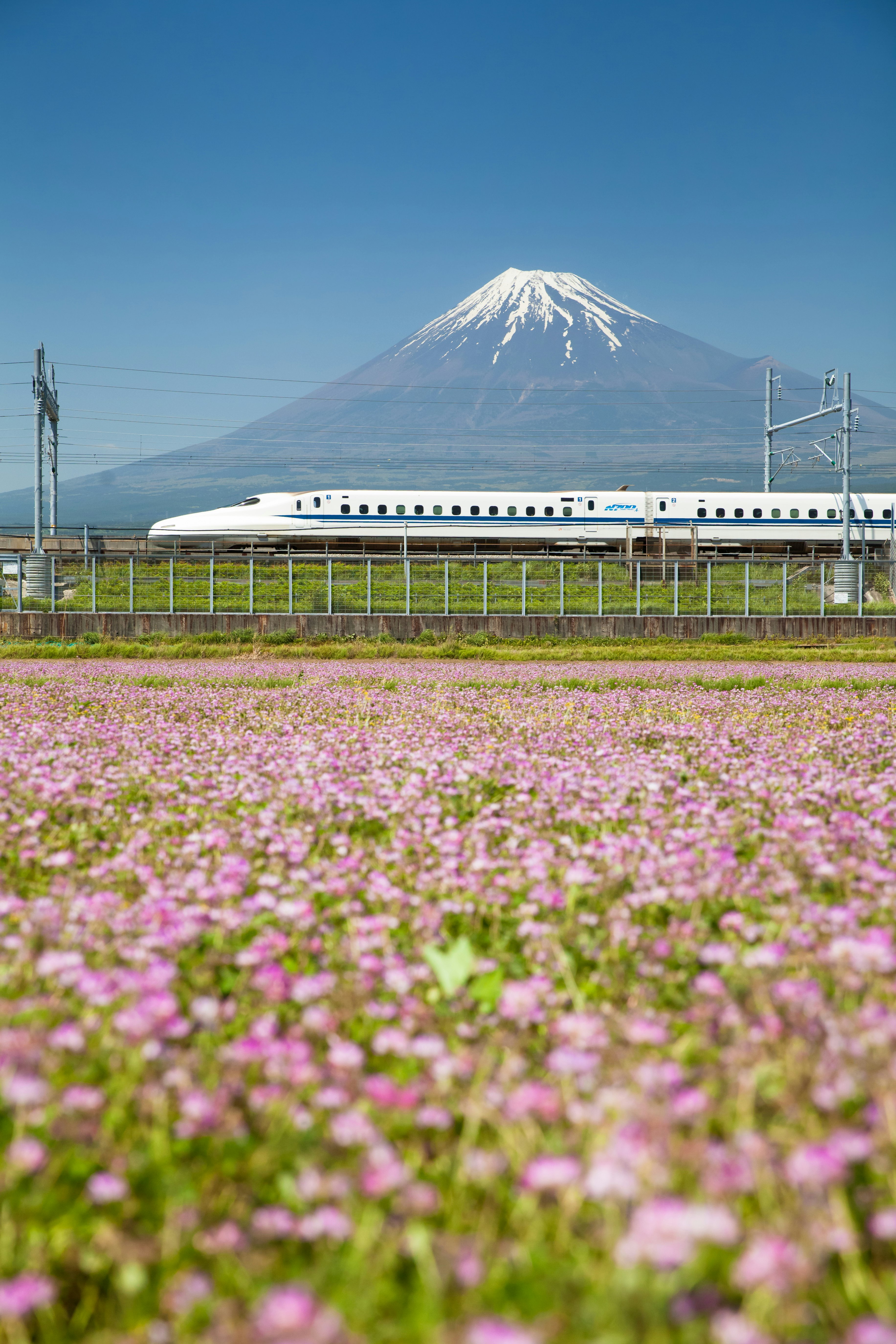

Mt Fuji towering over the Tōkaidō Shinkansen. ohayokung/Shutterstock
The Tōkaidō Shinkansen glides in and out of Tokyo Station with a precision that both fascinates and terrifies. It’s been two decades since I took my first ride – the first of many – and it still leaves me in awe.
Here, trains famously stop for just 12 regimented minutes – passengers have two minutes to disembark, after which a swift-footed cleaning crew has seven to sweep the whole train of 16 cars, readying it for the return journey. That leaves just three minutes for everyone – hundreds of people – to board, filing on in neat columns that form and reform like clockwork on either side of the doors. It’s a mesmerizing sight, with hypnotic rhythms not unlike another one of Japan’s accidental tourist attractions: the iconic Shibuya Crossing intersection.
There are now eight Shinkansen routes (not including a handful of branch lines), plus extensions in the works; the Tōkaidō Shinkansen, however, remains the most popular. It’s the one most people ride for the first time, as it travels to four out of five of Japan’s largest cities: Tokyo, Yokohama, Nagoya and Osaka. Former imperial capital and popular tourist destination Kyoto is also a stop en route.
There are three different services: the fastest, called Nozomi, does the trip in just under two-and-a-half hours. Before the Shinkansen, it took six hours to travel by train between Tokyo and Osaka, a distance roughly the same as London to Amsterdam, or Philadelphia to Boston. The other services, Hikari and Kodama, reach the same peak speed – 177mph (285km/h) – but take longer because they make additional stops.
Start: Tokyo Station
Finish: Shin-Osaka Station
Distance: 320 miles (515km)
Duration: 2 hours 22 minutes (fastest service)
Maximum speed: 177mph (285km/h)
Ticket types: There are two classes, Standard and Green, which is akin to Business Class with bigger seats and onboard refreshment service.
How to book: Use the dedicated Smart Ex app or reserve in person at counters or via vending machines at major Japan Rail train stations in Tokyo and elsewhere.

Departure
Regular riders – business travelers, for example, who use the Tōkaidō Shinkansen for day trips between branch offices – tap in and out of the automatic ticket gates like they’re riding the subway. First-timers, however, should give themselves plenty of time to navigate Tokyo Station, which is one of the city’s biggest and busiest, because the train will leave on time, whether you’re on board or not (never mind that seat reservation). The ideal time to head to the platform is 10–15 minutes before departure. This gives you enough breathing room to comfortably find the correct spot on the platform to queue, but you're not so early that you’re in the way, disrupting the natural flow of people.
As soon as the door closes – and maybe even before you’ve found your seat – the Shinkansen starts to accelerate swiftly. Not that you notice, really; that’s how smooth the ride is. Tokyo Station, built in 1914, is smack in the middle of the capital, in the Marunouchi business district. The Tōkaidō cruises on elevated tracks between skyscrapers, past housing complexes and alongside the metropolitan expressway. I love seeing the city from this vantage point. With a keen eye, I can pick out the details that define urban life in Japan: futons airing from residential balconies, pocket-sized parks, bus depots and high-school baseball fields enclosed in netting.

The journey
After Tokyo Station, the next stop is Shinagawa, also in Tokyo, followed by Shin-Yokohama, the station for Yokohama. It takes just 18 minutes to travel between the capital, Japan’s largest city, and Yokohama, its second largest – were it not for the stations, however, you’d hardly know you’d left one city and entered another.
The Tōkaidō Shinkansen traverses one of the most densely populated urban corridors in the world, a near-contiguous metro area on Japan’s Pacific coast that is home to roughly 65 million people – or more than half the country’s population. Trains depart approximately every five minutes (or every three minutes during peak hours), moving hundreds of thousands of people every day. If you think of this stretch as one giant megalopolis, then the Shinkansen is like its sophisticated, well-run metro.
This is not a scenic journey in the conventional sense. While the train runs near the coast, there are only a few glimpses of the water. Nor are there the kind of rural vistas that you get on the Tōhoku Shinkansen. What you do get, however, is a sense of Japan’s built space. Past Yokohama, the landscape gradually shifts to the suburban: two-story homes with slate-colored roofs, modest allotments, planned new towns, hilltop mansions, shopping centers and shipping warehouses.
There’s some exurban – small factories and farms – too, and a lot of tunnels: about 15% of the route is tunnels, particularly notable in the stretch between Odawara and Mishima (stops on the slower Kodama service), where the Tōkaidō Shinkansen runs through mountains just outside of Fuji–Izu–Hakone National Park.

Just as it all starts to feel a bit same-y, the train rounds a bend and I glimpse the journey’s majestic highlight – Mt Fuji, appearing on the right-hand side about 45 minutes into the trip, around Shin-Fuji Station. It’s a spectacular view – if it’s not cloudy – of not just the snowy crown but of the whole majestic cone rising abruptly from an alluvial plain. It’s a thrilling, classic moment, two beloved symbols of Japan, the Shinkansen and Mt Fuji, together.
On the Nozomi service, the train won’t stop again until Nagoya (Japan’s third-largest city) – where it pauses for just one minute to let passengers off and on – followed by Kyoto and Shin-Osaka. The Shinkansen stations in Kyoto and Nagoya are centrally located, which means you get a (brief) look at these cities before the final stop, to the north of Osaka proper. I always know when I’m nearing the end of the line because the remaining passengers start gathering their belongings, knowing they and I have mere minutes to disembark before the magic starts again.

Things to know
Eating etiquette
While eating on public transportation in Japan is generally a no-no, dining on board the Shinkansen is a time-honored custom. All Shinkansen stations have shops selling ekiben – a bento (boxed meal) from the train station ("eki") – packed neatly with chopsticks and a wet napkin. Look out for ones with local specialties; or get one in a souvenir container shaped like the iconic train.
Booking tips
For Mt Fuji views, book window seat E (on the right-hand side) when traveling from Tokyo to Shin-Osaka. Pay a little extra to reserve a seat; you also need to reserve space for large luggage.
This is an extract from Lonely Planet's new book Epic Train Trips of the World, published in September 2025.















